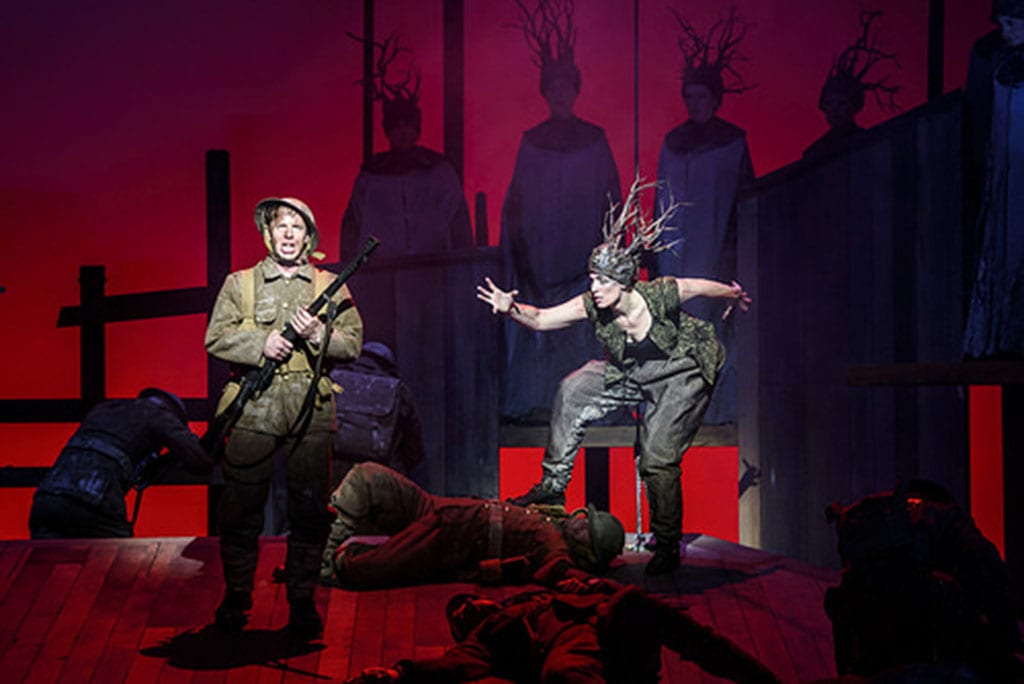When we think of the poetry of the First World War it is Owen and Sassoon who first come to mind, not the name of David Jones. However, when his epic prose-poem In Parenthesis first appeared in 1937, it was hailed by T.S.Eliot as a ‘work of genius’, and has long been admired in literary circles at least for his commentary on the war based on his first-hand experience, and its adaptation of themes from Welsh literature and history.
In adapting it as opera as part of the ‘14-18 NOW’ commemorations the librettists have simplified the poem’s many strands and focused on the story of Private John Ball (Andrew Bidlack) and his platoon of Royal Welch Fusiliers. The action describes their journey from embarkation at Southampton through to their arrival at the front line and ultimately to their sacrifice in Mametz Wood during the Battle of the Somme. This opera is not so much driven by plot as by evocation of mood and mythological associations. So, for example, when the soldiers leave England, there is a moving Chorus of Remembrance, the first of many interventions in the action, often driven by Welsh folk song.
The individual soldiers within the platoon are usefully distinguished from one another in their music, so that when they meet their deaths we have got to know them as characters. Somewhat less successful is the projection of the various hallucinations and visions experienced by Bidlack, which hold up the flow of the whole. The visionary aspect comes into its own when we reach the final mythological apotheosis in Mametz Wood, where the appearance of a Chorus of Dryads shifts gears from naturalism to symbolism, and death is replaced by a representation of regeneration and rebirth, of both men and landscape; and here the opera ends.
The musical language bears comparison to Britten’s in several respects. The opera is quite close at times to the War Requiem, with bold brass writing, strong hieratic chanting, and then moments of chamber-music intimacy as the voices interweave with particular instruments. The scenes of comradely intimacy, with exquisite close harmony writing, are reminiscent of Billy Budd; and the two commentators drift in and out of the action rather like the male and female chorus in the Rape of Lucretia. Nevertheless, Bell’s is an individual musical voice with great technical command of the orchestra and choral forces, and a true gift for matching memorable melody to dramatic climaxes, for example in the final scene when the ‘Queen of the Woods’ makes her appearance. The orchestral interludes are characterful and the choral writing in particular, both affecting and impressive.
Performance values are at a high level. Much of the vocal writing is taxingly evocative of bel canto, and Bidlack handles it with only occasional strain. Alexandra Deshorties takes full advantage of the opulent aria she is given at the end of the opera, and Donald Maxwell is his usual distinctive and distinguished self in the role of Dai Greatcoat. Carlo Rizzi controls the large forces firmly from the pit, and builds the various climaxes very effectively. In a work where there is often little action dynamic sets are crucial and a lot of credit belongs to Robert Innes Hopkins for creating spaces that are flexible enough for the large cast to operate within, but characterful too in their own right. The basic shape of the set did not change, but it was reinvented between scenes speedily and with real originality.
Contemporary opera often gets a bad press for confronting its audiences needlessly. However, this work manages to challenge its audience in the handling of its themes and to move us through the way it finds new means to evoke and inhabit ‘the pity of war’. Innovation is harnessed to dramatic context in a way that does credit to the whole creative team.

